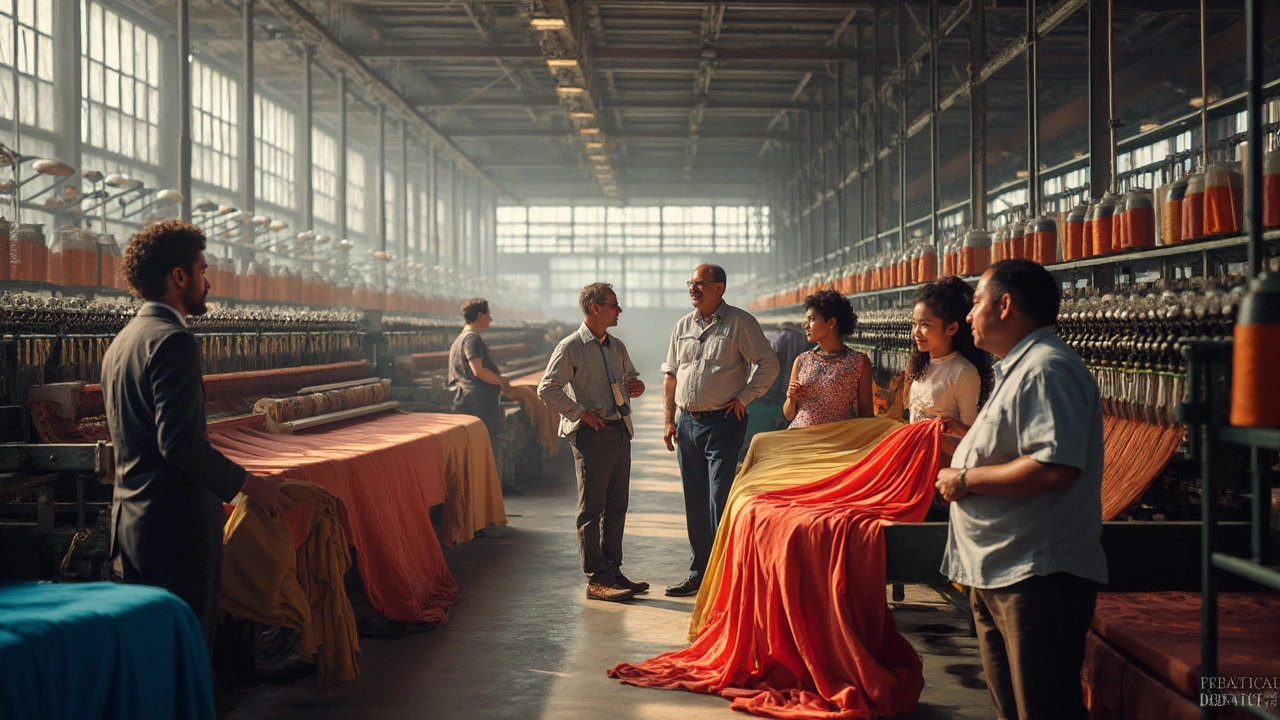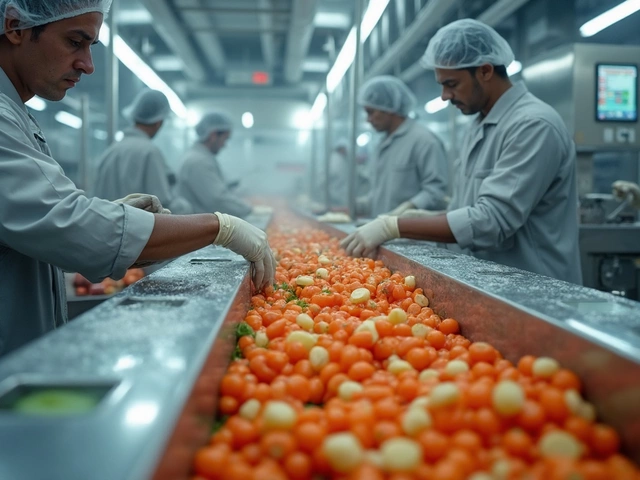Most people picture New York or Los Angeles when they think of US fashion, but the real textile action happens in Greenville, South Carolina. This city has been called the “Textile Capital of the World,” and for good reason. Walk around Greenville, and you’ll bump into old mills, buzzing trade shows, and experts who breathe fabric. If you’re in India’s textile biz, knowing the ins and outs of Greenville can really change the way you connect with the American market.
Greenville’s textile roots run deep. Around a century ago, huge spinning mills and weaving factories put this city on the map. Today, it’s less about churning out piles of fabric and more about innovation—smart textiles, sustainable practices, and close partnerships between manufacturers and big brands. Anyone thinking about exporting fabrics or yarn from India will find Greenville’s connections and know-how are still a massive asset.
- Why Greenville, South Carolina Stands Out
- Key Facts About Greenville’s Textile Scene
- Tips for Linking Indian Manufacturers With the US Market
- Reasons the Textile Game Keeps Evolving
Why Greenville, South Carolina Stands Out
When you talk about the textile capital US, Greenville pops up every time. It’s not just talk—the city earned that title over years of leading the pack in textiles. By the 1940s, about a quarter of the entire state’s workforce clocked in at a mill, and most of those mills sat in and around Greenville. Names like Parker Mill and Poe Mill were everywhere. If someone mentioned "the upstate" in a textile meeting, everyone knew it meant Greenville.
But it’s not only history that puts Greenville on the map. The city hosts the International Textile Alliance’s trade events, turning it into a magnet for designers, suppliers, and buyers across the US. Major companies like Milliken, Sage Automotive, and Kentwool keep their headquarters or major facilities nearby. That means anyone connecting with textile manufacturers India to the US market will hear about Greenville’s critical role.
Greenville’s secret sauce is how it balances old and new. The old brick mills are still there, but most have found new life as event spaces or lofts. Meanwhile, research centers like Clemson University’s Center for Advanced Fibers and Textiles push the industry into the future with tech like smart fabrics and recycled yarn. This mix gives Greenville an edge—it’s rooted in tradition but open to change.
- Home to over 200 textile-related companies as of 2024.
- The Greenville-Anderson-Mauldin area is a top spot for textile patents.
- The city offers easy shipping with interstates and railway links, making fabric movement fast and reliable.
- Local colleges fuel new ideas and keep the labor market skilled.
Check out these stats that show why Greenville matters for anyone eyeing the textile industry USA:
| Year | Active Textile Businesses | Major Trade Events Held |
|---|---|---|
| 2015 | 122 | 3 |
| 2020 | 170 | 5 |
| 2024 | 210+ | 8 |
That constant growth isn’t just random. Local government and business groups invest big money in technology and training so Greenville stays ahead. If you want a foothold in the fabric production USA scene, this is the city you can’t ignore.
Key Facts About Greenville’s Textile Scene
Greenville’s title as the textile capital US wasn’t just luck. In the early 1900s, more than half the world’s cotton was spun and woven in mills within a hundred-mile stretch around this town. You’ll still spot old brick mills, some turned into trendy offices, but their history is a badge of the city’s legacy.
Right now, Greenville is way more than museum pieces. The city is home to Textile Hall, which used to host the world’s biggest cotton shows. Today, the tradition lives on with the Southern Textile Exposition, one of America’s top textile trade events, where folks from all over—especially countries like India—come to strike deals and talk shop.
If you peek at the local economy, you’ll see fabric research labs and tech centers everywhere. Big companies like Milliken & Company, and international names like Sage Automotive Interiors, have major operations here. They focus on new fabrics—think fire-resistant cloth, waterproof surgery gowns, or yarns made from recycled plastic. It’s not just about volume now; it’s about smarter goods.
Numbers tell the story better:
| Fact | Detail |
|---|---|
| Major Industry Players | Milliken & Company, Sage Automotive Interiors, and Kentwool |
| Trade Events | Southern Textile Exposition (annual), Techtextil North America (sometimes hosted nearby) |
| Historic Legacy | Over 80 mills once operated in the region during the peak |
| Focus Today | Technical textiles, recycling, smart fabrics, and textile technology |
Greenville works closely with the global market. Lots of American brands now connect with textile manufacturers India through the contacts and networks that Greenville has kept alive for decades. So whether you’re selling yarn or looking for partners, this city has both the past and the savvy for future moves.

Tips for Linking Indian Manufacturers With the US Market
If you’re a textile manufacturer in India eyeing the US market, Greenville should be your not-so-secret weapon. The city may look small on the map, but it packs a punch with trade connections, business-friendly rules, and an established network of textile buyers.
First up, know the key shows and expos—these are gold mines for making deals. The Southern Textile Association’s events and the Techtextil North America expo both pull in buyers, product developers, and supply chain managers from all over the country. Showing up at these events in Greenville can lead to business partnerships much faster than endless cold emails.
What gets Greenville’s textile industry excited? Think high-performance fibers, sustainable production, and automation. US brands are asking more about eco-standards, so if you can offer GOTS or OEKO-TEX certified products, highlight this in your pitch. Buyers also like samples—send in-person swatches with details on your minimum order quantities and shipping times.
Don’t be surprised if the conversation gets technical. Greenville is home to big textile R&D players like Milliken & Company, and the staff there love to talk coatings, finishes, and next-gen fabric blends. If you’re exporting yarn, fabric, or finished goods, get someone on your team brushed up on US safety and labeling laws to keep shipments moving through customs.
- Register with the US Commercial Service’s matchmaking programs—they help link overseas suppliers with US importers.
- Brush up on INCOTERMS and basic US import forms (section 321, invoices, packing lists, etc.).
- Use LinkedIn to network directly with the supply chain heads at US brands—most have profiles and are open to connections, especially after big Greenville events.
- If you offer custom production or smaller batch runs, highlight your flexibility. Greenville buyers love working with suppliers who can pivot quickly as market trends shift.
Here’s a quick look at what US buyers often want from textile manufacturers in India:
| Key Requirement | Why it Matters |
|---|---|
| Certifications (GOTS, OEKO-TEX) | Proof of sustainability and safety |
| Fast lead times | US retail cycles move quick—speed is key |
| Clear communication | Buyers want updates and honest info if issues come up |
| Custom samples | Makes a strong first impression and lets buyers check quality firsthand |
Tapping into Greenville’s business scene can give Indian suppliers a direct line to US trends—and the buyers shaping them. Keep things simple, stay flexible, and always know what’s hot in the textile capital of the US.
Reasons the Textile Game Keeps Evolving
If you think the textile industry USA is all about old mills and traditional fabrics, you’re missing the real story. The game is always changing, and Greenville, South Carolina is right in the thick of it. The city’s approach shows how this industry adapts—thanks to new tech, consumer habits, and links with global players like textile manufacturers India.
The first big push? Tech upgrades aren't just for Silicon Valley. Greenville’s mills have switched to smart machines that spot defects in fabric way faster than human eyes. That means better quality and less waste. Plus, the demand for eco-friendly processes isn’t a trend—it’s a must. According to the National Council of Textile Organizations, over 70% of US mills have updated their tech in the last decade.
“We’re not just selling fabric, we’re selling smarter, greener production,” said John Plant, CEO of a major Greenville-based textile firm, during the 2024 Southern Textile Expo.
But it’s not just about the machines. People want fabrics that breathe, stretch, and resist stains—and they want to know how those fabrics are made. This is where the connections with countries like India come in. Indian manufacturers often supply specialty fibers or help with high-volume orders, so both sides win. If you plan to work with US partners, being upfront about your processes and quality checks helps you stand out.
- Textile capital US companies are working on 'traceable textiles,' where every part of the process—from the cotton field to the final shirt—can be tracked.
- Investing in training keeps workers sharp as jobs get more technical. Local colleges offer programs just for textile tech, keeping Greenville’s talent pool fresh.
- Many brands expect partners to follow strict sustainability and labor rules, so certifications like OEKO-TEX or GOTS help Indian exporters get a foot in the door.
Just to get a better picture, here’s how Greenville’s textile focus has shifted in the last few years:
| Focus Area | 2015 | 2024 |
|---|---|---|
| Traditional apparel production | 55% | 25% |
| Technical textiles (medical, automotive) | 10% | 40% |
| Sustainable & smart textiles | 5% | 20% |
So, the textile capital US stays on top not because it sticks to old habits, but because it adapts fast. If you’re in this game, keeping up with these shifts, especially around tech and sustainability, is the only way to win.






